B Melodic Minor Scale Theory
Let's delve into the B melodic minor scale in this music theory lesson. This diatonic scale starts and ends on a B, and was originally created to aid in composing melodies. When played in ascending order, the melodic minor scale shares the same pitches as a major scale, but with a flat third. On the other hand, when played in descending order, it has the same notes as a natural minor scale.
Notes on the B melodic minor scale
Here are the ascending notes of the B melodic minor scale: B, C#, D, E, F#, G#, A#
The scale notes of the B melodic minor descending are: B A G F# E D C#
The B melodic minor scale intervals
The melodic minor scale is similar to the natural minor scale, but with a raised 6th and 7th degree by a semitone (half step) on the way up. However, when played in descending order, it is identical to the natural minor scale. This alteration changes the minor 2nd interval between the 5th and 6th notes to a major 2nd interval. Additionally, there is another major 2nd interval between the 6th and 7th notes. A major 2nd is equivalent to a tone or a whole step, such as E-F# and F#-G#.
Below, you can find a one-octave B melodic minor scale with labeled intervals. It's important to note that these intervals are the same for all ascending melodic minor scales.

The descending order of the melodic minor scale shares the same intervals as the natural minor scale. These intervals are illustrated below.

The Melodic Minor Scale Formula
The formula for the melodic minor scale is derived from the natural minor scale, but with different notes for ascending and descending orders.
- When played in ascending order, the 6th and 7th degrees are raised by a semitone.
- When played in descending order, these notes are lowered to match the natural minor scale formula.
Play B melodic Minor
On the piano
To play the ascending and descending versions of the melodic minor scale with your right hand, refer to the diagram below. The fingerings are indicated beneath the notes.

To play the ascending and descending versions of the melodic minor scale with your left hand, refer to the diagram below. The fingerings are indicated beneath the notes.

On the guitar
The melodic minor scale can be played in various positions on the guitar. The standard position, starting on a B, is shown below. This shape can be shifted up and down the neck to play different ascending melodic minor scales.
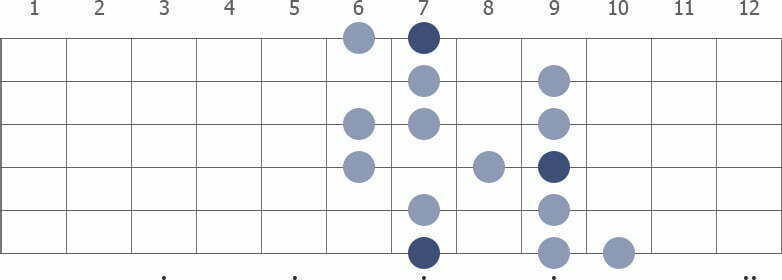
The Key Signature Of B melodic Minor
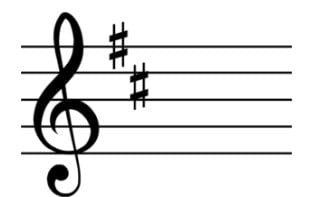
When composing pieces in a minor key, the melodic minor scale is often used. For instance, if we play the B melodic minor scale, the piece will be in the key of B (natural) minor. B minor is the relative minor of the D major scale, and both scales share a key signature of two sharps.
B melodic Minor In Different Clefs
Below is the B Melodic Minor Scale written in the treble clef, bass clef, alto clef and tenor clef including both ascending and descending.
Treble clef
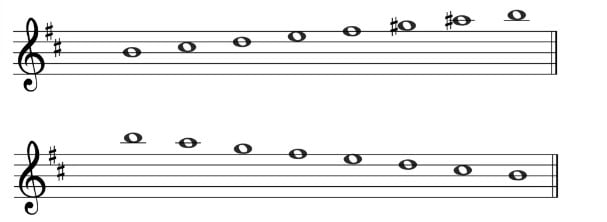
Bass clef
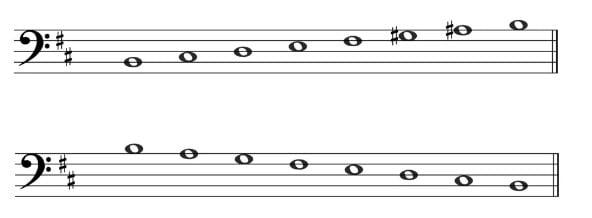
Alto clef
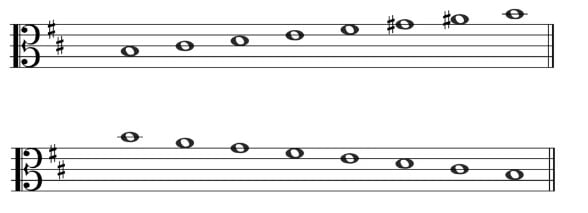
Tenor clef
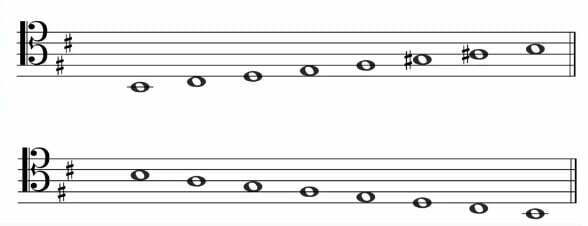
The B melodic minor scale is a captivating and versatile musical scale that adds a touch of drama and complexity to compositions. Understanding its theory and exploring its possibilities can open up new avenues for musical expression. So go ahead, experiment with the B melodic minor scale, and let your creativity soar!








